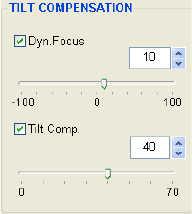
3.9.9
3 - 135
Fig. 3.9-24 TILT COMPENSATION Window
Use the following steps to focus the entire field.
(a) Set the Raster Rotation angle at 0. In this condition, direction of the scanning beam
coincides with the specimen tilting direction.
(b) Check the Dynamic Focus box and focus the image so that the center of the image is
focused. Adjust the Dynamic Focus slider so the whole image is in focus.
(c) Alternately, use the Reduce 2 scanning speed. After focusing the center part of the
image, set the scanning speed at Reduce 2 and move the scanning area to the top of
the screen. Adjust Dynamic Focus slider for the best focus.
Take the following steps to use Tilt (magnification) compensation.
(d) Check the Tilt Compensation box, and set the angle to the specimen tilting angle
(move the slider or input an angle into the angle indication box).
NOTICE: If magnification, WD, or accelerating voltage is changed, the Dynamic Focus slider
needs to be re-adjusted.
Tilting the specimen extensively can cause distortion in the observed image at a low
magnification or low accelerating voltage as the electron beam undergoes a rotation in
the objective lens magnetic field.
At SLOW1 or faster scanning speed, unexpected defocusing may appear in the image.
It is caused by a slow response of the magnetic field of the objective lens.
Tilt Compensation may result in an unnatural image when a specimen has three-
dimensional structures.
